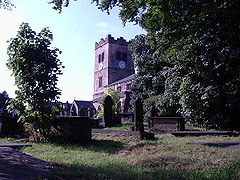Drighlington
| Drighlington | |
|---|---|
 St Paul's Church |
|
| Drighlington shown within West Yorkshire | |
| Population | 5,528 (2011) |
| OS grid reference | SE2229 |
| Metropolitan borough | |
| Metropolitan county | |
| Region | |
| Country | England |
| Sovereign state | United Kingdom |
| Post town | BRADFORD |
| Postcode district | BD11 |
| Dialling code | 0113 |
| Police | West Yorkshire |
| Fire | West Yorkshire |
| Ambulance | Yorkshire |
| EU Parliament | Yorkshire and the Humber |
| UK Parliament | |
Drighlington /ˈdrɪɡlɪŋtən/ is a village and civil parish in the City of Leeds metropolitan district, West Yorkshire, England. Historically part of the West Riding of Yorkshire, the village lies 5 miles (9 km) south west of Leeds and 4 miles (6 km) south east of Bradford. The name of the village is often shortened to Drig. The population of the civil parish as of the 2011 census was 5,528.
The earliest mention of Drighlington is to be found in the Domesday Book where it is described as "Dreslintone", and its modern name is derived from this root. The Roman road from York to Chester ran through the village and its mark may be seen in the more or less straight run from Birkenshaw to Drighlington traffic lights.
In 1576 Queen Elizabeth I granted Letters of Patent to one James Brooke allowing him to hold a market every second Thursday and two horse and cattle fairs annually. These fairs took place at the White Hart public house (now demolished).
The village is also the site of the Battle of Adwalton Moor fought on 30 June 1643 in the First English Civil War between the armies of King Charles I and the Parliamentarians. The Royalist army under the Earl of Newcastle defeated the Parliamentarians under the command of Lord Ferdinando Fairfax and his son Sir Thomas. There are four commemorative stones with plaques depicting the battle at strategic points around the common and there is an information board on the wall of the community hall.
...
Wikipedia

